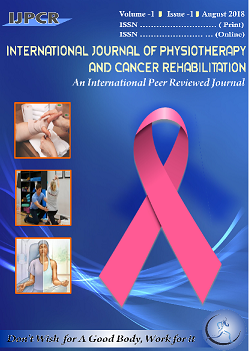International Journal of Physiotherapy and Cancer Rehabilitation
SEARCH
Our Founder
Popurlaly known as ‘jannu bhai’, the Late manishi’s vision, farsightedness and sacrifice have enabled us reach the stature we enjoy today More...Vice Chancellor's Message
It gives me immense pleasure to learn that the 1st volume of international journal of physiotherapy and cancer rehabilitation is being More...Cover Page Volume I Issue I
 .
.
IJPCR
Role of Menthol infused type in Lymphoedema management
HARPREET S SACHDEV, M.P.T. MIHIR SOMAIYA, MPT Physiotherapist, India
Abstract:
Introduction: The human lymphatic system comprises lymphatic vessels and lymph nodes running parallel to the circulatory system. Lymphoedema occurs when there is an imbalance due to reduced lymph transport capacity leading to accumulation of interstitial fluid and protein. This failure of lymphatic system to adequately transport excess water, proteins and waste products away from the affected area results in a chronic inflammatory response manifesting as swelling, and lead to skin and tissue changes. This abnormal accumulation of protein rich interstitial fluid resulting from insufficient lymphatic drainage has serious multiple, disabling and chronic sequelae too. Secondarily proliferation of neutrophils, macrophages and fibroblasts along with accumulation of collagen leads to chronic inflammation and fibrosis. Apart from reported deleterious effects on patients physical and psychological well being, it has been widely documented that lymphoedema affects body image, reduces self esteem, causes pain, discomfort, functional impairments, depression, anxiety and problems with sexual, familial and social relationships. Lymphoedema increases the risk of cellulitis and frequency of hospitalization. Cancer related lymphoedema commonly occurs after treatment of breast cancer, with a prevalence of 6-54%. Upper limb lymphoedema occurs in 24 – 49 % of cases with total mastectomy and in 2 -49 % of cases with axillary lymph node dissection. Cancer related damage to the lymphatic system occurs as a result of surgery, radiotherapy or progression of the neoplastic disease.
Mechanism of action: Move kinetic tapes have been suggested as a promising treatment option for acute sport injuries, musculoskeletal disorders and also edema. One of the physiological effects of the tape is decongestion of lymphatic fluid accumulated under the skin. Move kinetic tapes can provide directional pull that guides the lymph fluid in the desired direction of drainage. This is important in routing and rerouting the lymphatic fluid in the lymphatic vessels, and thus reducing swelling and edema. After applying the kinetic tape, the taped area will form convolutions to increase the space between the skin and muscle. Once the skin is lifted, the flow of blood and lymphatic fluid is promoted. Application of kinetic tapes increases the pressure difference within lymph vessels, increases the flexibility of underlying connective tissue, and also induces a micromassaging effect.